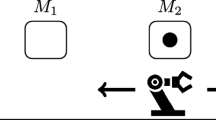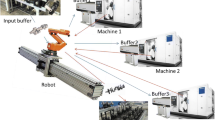Abstract
This study deals with scheduling problem of a flexible robotic cell with m-machines and a robot. The machines are identical, and each machine performs all of the processes for producing a finished product. These machines are arranged in a line where one input buffer and one buffer are put at the beginning and the end of the line, respectively. A robot transports parts between the machines and the input and output buffers. In this cell, each machine processes one part in each cycle. Since the cycle time depends on the order of the activities of the robot, for minimizing the cycle time, the order of the activities of the robot should be determined. A universal scheduling model of the problem is developed, and its reduced version is provided, excluding waiting time variables. Furthermore, a new model is proposed for maximizing the minimum robot return time to the machines in a cycle. The developed models numerically examined based on obtained products order from the reduced model for the cell with up to six machines. Moreover, the assignment problem method is used for determining lower bond results of the developed model and/or the optimal results (i.e., in case the operation times of the machines are small enough and the robot waiting time is zero). The results indicate that the reduced version of the model is significantly more efficient compared to the model of the literature.
Similar content being viewed by others
References
Gultekin H, Dalgıç ÖO, Akturk MS (2017) Pure cycles in two-machine dual-gripper robotic cells. Robot Comput Integr Manuf 48:121–131. https://doi.org/10.1016/j.rcim.2017.03.004
Crama Y (1997) Combinatorial optimization models for production scheduling in automated manufacturing systems. Eur J Oper Res 99(1):136–153. https://doi.org/10.1016/S0377-2217(96)00388-8
Agnetis A, Pacciarelli D, Rossi F (1996) Lot scheduling in a two-machine cell with swapping devices. IIE Trans (Inst Ind Eng) 28(11):911–917
Drobouchevitch IG, Sethi SP, Sriskandarajah C (2006) Scheduling dual gripper robotic cell: one-unit cycles. Eur J Oper Res 171(2):598–631. https://doi.org/10.1016/j.ejor.2004.09.019
Dawande M, Geismar HN, Sethi SP, Sriskandarajah C (2005) Sequencing and scheduling in robotic cells: recent developments. J Sched 8(5):387–426. https://doi.org/10.1007/s10951-005-2861-9
Sethi SP, Sriskandarajah C, Sorger G, Blazewicz J, Kubiak W (1992) Sequencing of parts and robot moves in a robotic cell. Int J Flex Manuf Syst 4(3–4):331–358. https://doi.org/10.1007/BF01324886
Papakostas N, Michalos G, Makris S, Zouzias D, Chryssolouris G (2011) Industrial applications with cooperating robots for the flexible assembly. Int J Comput Integr Manuf 24(7):650–660. https://doi.org/10.1080/0951192X.2011.570790
Gultekin H, Akturk MS, Ekin Karasan O (2007) Scheduling in a three-machine robotic flexible manufacturing cell. Comput Oper Res 34(8):2463–2477. https://doi.org/10.1016/j.cor.2005.09.015
Gultekin H, Ekin Karasan O, Akturk MS (2009) Pure cycles in flexible robotic cells. Comput Oper Res 36(2):329–343. https://doi.org/10.1016/j.cor.2007.10.007
Aktürk MSM, Atamtürk A, Gürel SN (2009) A strong conic quadratic reformulation for machine-job assignment with controllable processing times. Oper Res Lett 37(3):187–191. https://doi.org/10.1016/j.orl.2008.12.009
Zeballos LJ (2010) A constraint programming approach to tool allocation and production scheduling in flexible manufacturing systems. Robot Comput Integr Manuf 26(6):725–743. https://doi.org/10.1016/j.rcim.2010.04.005
Jolai F, Foumani M, Tavakoli-Moghadam R, Fattahi P (2012) Cyclic scheduling of a robotic flexible cell with load lock and swap. J Intell Manuf 23(5):1885–1891. https://doi.org/10.1007/s10845-011-0505-9
De Giovanni L, Pezzella F (2010) An improved genetic algorithm for the distributed and flexible job-shop scheduling problem. Eur J Oper Res 200(2):395–408. https://doi.org/10.1016/j.ejor.2009.01.008
Batur GD, Karasan OE, Akturk MS (2012) Multiple part-type scheduling in flexible robotic cells. Int J Prod Econ 135(2):726–740. https://doi.org/10.1016/j.ijpe.2011.10.006
Musharavati F, Hamouda AMS (2015) Multiple parts process planning in serial-parallel flexible flow lines: part I—process plan modeling framework. Int J Adv Manuf Technol 78(1–4):115–137. https://doi.org/10.1007/s00170-014-6616-7
Musharavati F, Hamouda A (2015) Multiple parts process planning in serial–parallel flexible flow lines: part II—solution method based on genetic algorithms with fixed- and variable-length chromosomes. Int J Adv Manuf Technol 77(5–8):1105–1143. https://doi.org/10.1007/s00170-014-6459-2
Yildiz S, Karasan OE, Akturk MS (2012) An analysis of cyclic scheduling problems in robot centered cells. Comput Oper Res 39(6):1290–1299. https://doi.org/10.1016/j.cor.2010.09.005
Zhou B-h, Li M (2017) Scheduling method of robotic cells with robot-collaborated process and residency constraints. Int J Comput Integr Manuf:1–15. https://doi.org/10.1080/0951192X.2017.1328561
Nie X, Chen X, Chen X (2016) Simulation study of flexible manufacturing cell based on token-oriented petri net model. Int J Simul Model (IJSIMM) 15(3)
Barenji RV, Barenji AV, Hashemipour M (2014) A multi-agent RFID-enabled distributed control system for a flexible manufacturing shop. Int J Adv Manuf Technol 71(9–12):1773–1791. https://doi.org/10.1007/s00170-013-5597-2
Hernández-Pérez H, Salazar-González J-J (2004) A branch-and-cut algorithm for a traveling salesman problem with pickup and delivery. Discret Appl Math 145(1):126–139. https://doi.org/10.1016/j.dam.2003.09.013
Author information
Authors and Affiliations
Corresponding author
Rights and permissions
About this article
Cite this article
Ghadiri Nejad, M., Kovács, G., Vizvári, B. et al. An optimization model for cyclic scheduling problem in flexible robotic cells. Int J Adv Manuf Technol 95, 3863–3873 (2018). https://doi.org/10.1007/s00170-017-1470-z
Received:
Accepted:
Published:
Issue Date:
DOI: https://doi.org/10.1007/s00170-017-1470-z




